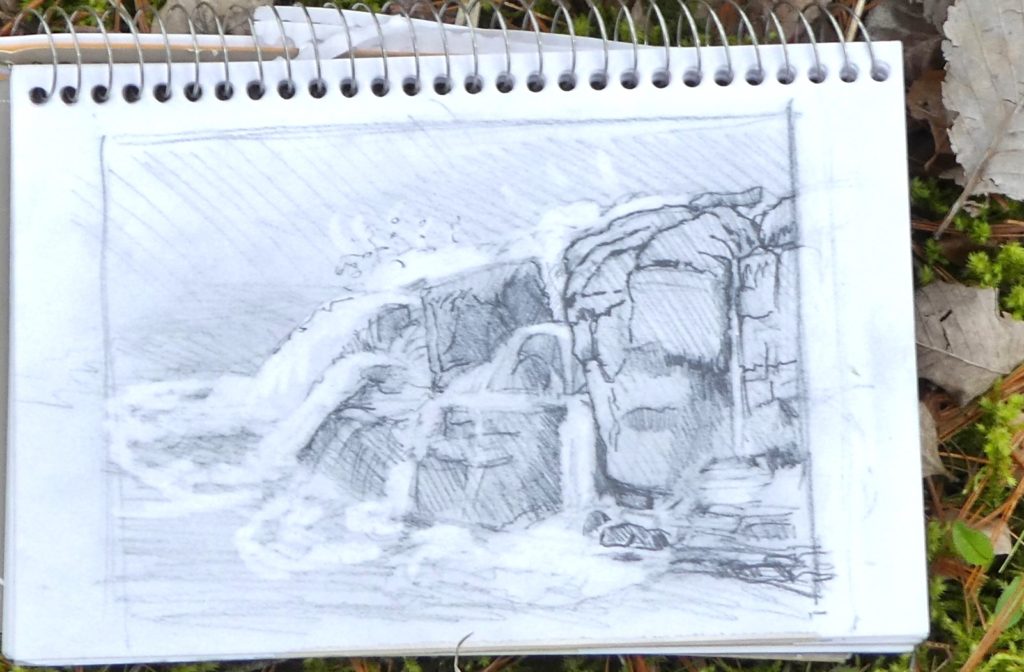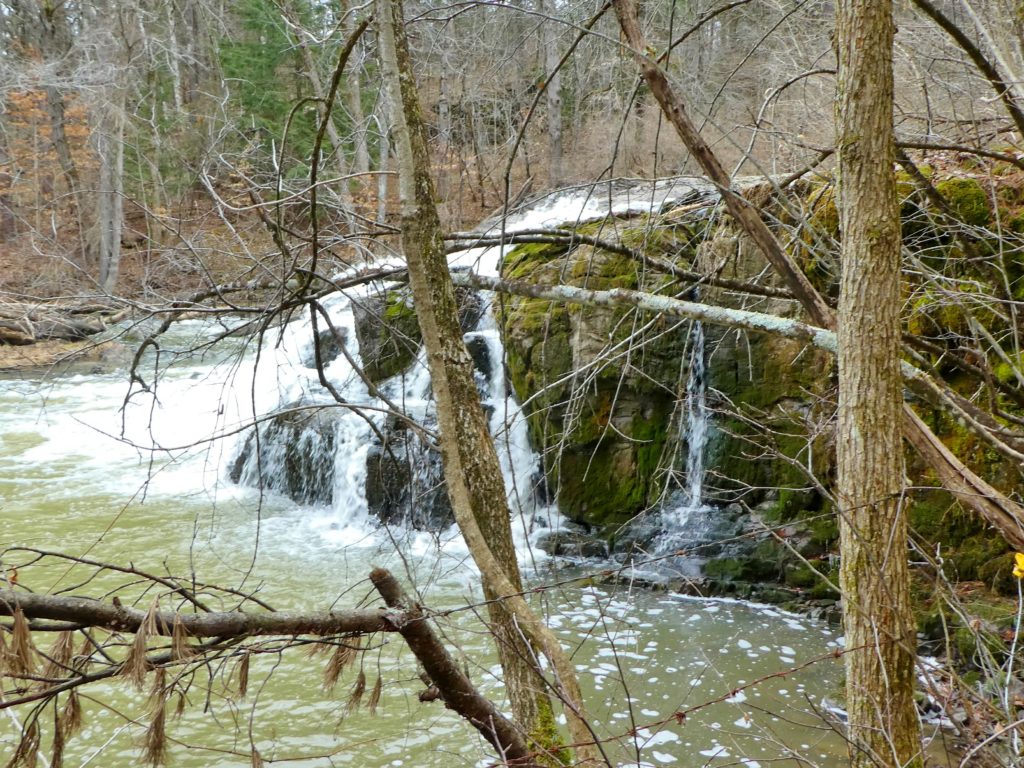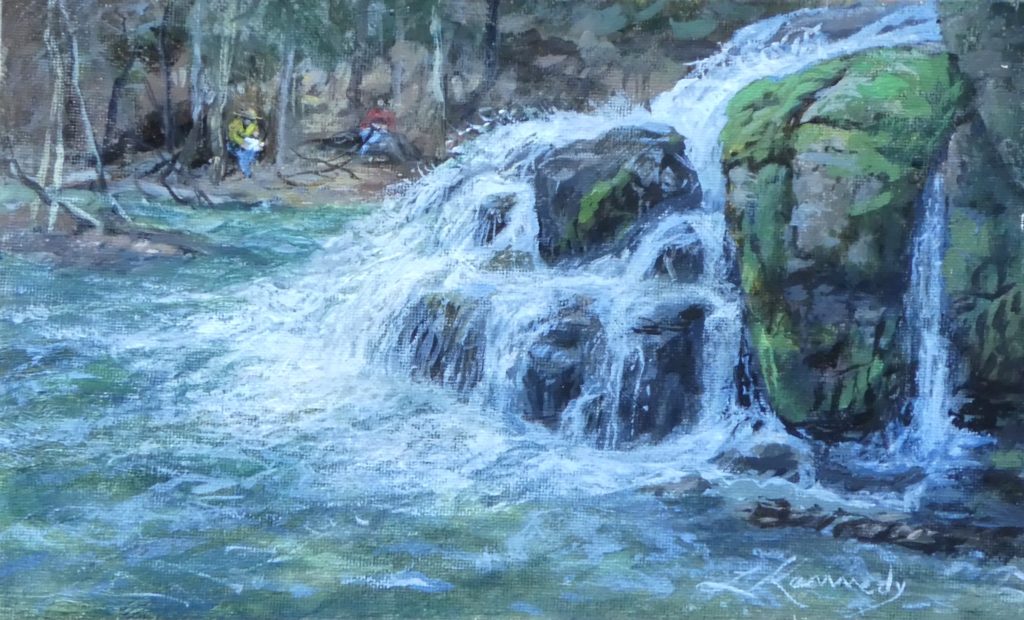Our focus this week is flowing water and I will outline the steps for a mindful drawing practice and a way to do the assignment even if you don’t leave your home.
1. Find your water. If you can safely go outside and find flowing water to sit near, this will be preferable. Take your own chair or cover a bench with a plastic garbage bag. When you stand to retrieve the bag, lift it so that you only touch the side that faced you. This technique works for soggy ground as well (or any surface that you don’t want to sit on).
If you are staying inside, go to Google and type in the kind of water you want to visit: waterfall, ocean, etc. After you click, you will have the option of choosing Videos in the top bar. Generally you will have lots of choices. I just tried it by entering “flowing streams” and found the following lovely scene with a beautiful natural soundtrack. The video lasts for six hours, so you will have plenty of time to do your homework while watching it.
2. Settle in. You’ll be here awhile. Gather yourself and your thoughts and come into the present moment. Make yourself as comfortable as you can. Take several deep breaths. Sink down and feel your energy go deep down and spread out into the earth. Ground yourself and come into the present moment by gazing at the moving water. Take your time doing this step.
3. Connect. As you gaze at your flowing water, begin to connect. Subject– to eyes — to heart– to hand — to paper — and back to the view. Do this by slowly moving your hand over the paper while you look at the scene. You can touch down on the paper and begin to place the elements in your view. Spend most of the time looking at the subject.
You will become more and more intimate with your chosen subject the longer you look. You will truly begin to feel how all things really are connected. You will begin to sense geological time (how the rocks were formed and how they arrived in this particular spot). You will be in touch with the ever changing aspect of life (the water that you saw in the stream when you sat down might be miles away when you stop). The light will change as you work. Stay long enough and the season will change. You will start to go with the flow. I’m hoping that you become entranced as your focus steadies.
Start becoming aware of what interests you most in the scene as you deepen your connection to the view.

4. Start to draw. You may go through several sheets of paper before you settle on the placement (composition) that you want to spend time developing. You don’t need to draw the whole scene, you can fill the page with just a small portion of what is in your view whether you are in nature or watching a video.
Roughly indicate the relative proportion of the elements. Make many lines not just one “right” line. These discovery lines add interest. In the end, you may want to erase some of them. Don’t erase at this stage. The “wrong” line can guide you in seeing where the next line might be placed as you circle around and back to a shape many time.
 This is the view of the falls from where I sat to draw. Sometimes you will need to lean and bob to see around things. These obstructions didn’t bother me at the time.
This is the view of the falls from where I sat to draw. Sometimes you will need to lean and bob to see around things. These obstructions didn’t bother me at the time.
5. Deep observing while drawing. Once your page is lightly composed take a moment to resettle yourself. Now you will slow your looking. Pick one of the areas that interests you the most and place your pencil on the corresponding area on your paper and looking closely, begin to draw what you see. Check back to your paper to adjust your shapes and proportions. What you are aiming to do is move your pencil as your eye moves. As your eye slides along an edge, your hand will slide over the paper. Don’t judge. It’s the experience we’re after. If you always look up to note a shape and then look down to draw it, you will always be doing a drawing from memory. That’s okay, but give this a try. Glance down a your paper but then look back up.
6. Move around the drawing and see the whole. Don’t get stuck in the area where you start slow seeing. If you feel frustrated or feel like quitting shift to another area. Your hand dances around the page while you focus on different things and you will be going back to the same areas again and again. Feel how each new area where you work interrelates to the other areas. You want to whole composition to hang together as a whole.
If you are confused by theses steps, watch the video in lesson #2 again to see the process in action. Click below on the Lesson #2 headline. Don’t forget to return to this lesson after you watch.

Endless THANKS to Dave Sullivan who saved this blog site. Volunteering through the Bixby Library in Vergennes, VT, he is unraveling and repairing the problems for me as they appear.
The site had been hacked and was all in Arabic – I kid you not! It had cars and things and I couldn’t access any of it. He leaned into the problem with a keen interest that I understand better now that I know that he has his own blog about Crossword puzzles and has created puzzles for the New York Times. It does take a village to make most things happen, and it sure helps that a generous and gifted man such as Dave is here in mine .
